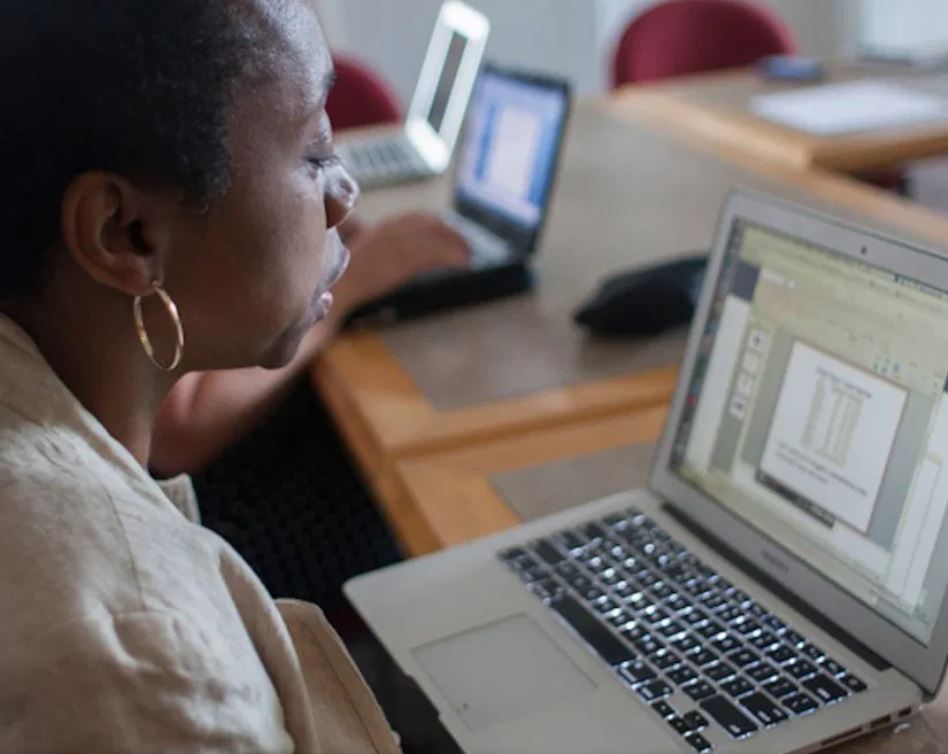Teachers need lots of training to do online learning well. Coronavirus closures gave many just days.
After the Arizona State University Preparatory Academy announced on Friday, March 13, that it would shift its 11 schools to online learning because of the coronavirus crisis, teacher Theresa Ordell switched to high gear. The next Monday she was at her school, South Phoenix Primary and Intermediate, to get ready.

The 51-year-old teacher racked up 14,000 steps that day assembling bags of books and worksheets for families of her third and fourth-grade students to pick up as they were let in, five at a time, to the public charter school in South Phoenix, Arizona. Families who needed devices for their kids also picked up Chromebooks. The rest of the day was devoted to reviewing the academy’s virtual learning plan and training teachers for the move from classroom to screen.
Ordell practiced using the video conferencing platform Zoom so she’d be ready to lead class online with her students the next day. Before leaving, she grabbed game buzzers, a bell that says “Ring for Coffee,” a whiteboard, and colorful dry-erase markers in a green basket and other items from her classroom.
“Anything that made their routine seem familiar, I snatched it up, loaded up the car, came home and next day we were life,” said Ordell, whose students laughed Tuesday morning when she played the classroom theme song, “Get Back Up Again,” from the movie Trolls. “I said, ‘Yeah, with COVID-19 we are going to get back up again.’ We made it work.”
Experts say teachers ideally should receive several days, weeks, or — better — months of in-depth preparation before launching an online learning program. Training should include strategies to make the instruction engaging and allow ample time to practice the technology before going live. But as more than 124,000 schools in the U.S. have closed to prevent the spread of the coronavirus, district leaders eager to keep students learning are pushing teachers to pivot quickly to online learning. Many teachers received a couple of days of training before being asked to overhaul nearly every facet of their job. The lucky ones had a couple of weeks.
“Anything that made their routine seem familiar, I snatched it up, loaded up the car, came home and next day we were live.”
Teacher Theresa Ordell, South Phoenix Primary and Intermediate School, part of the ASU Preparatory Academy in Arizona
Teachers are doing their best in an unprecedented and constantly changing situation, but the varying amount of training districts are providing has created a patchwork of quality and gaps inaccessibility. In New York City, the nation’s largest school district, teachers were given three days of training, after schools were closed, which included peer-to-peer sessions in which teachers shared with each other how to use Google Classroom and other platforms. Many teachers are improvising and counting on patience from parents and students as they transition to online learning on the fly.
“The biggest problem is there is not enough time to really do the training that a teacher needs to understand how to teach online,” said Jennifer Mathes, interim chief executive officer of the Boston-based Online Learning Consortium, a nonprofit that offers webinars and resources on online teaching and learning. “What we are doing right now is more of a Band-Aid to say these are tips and tricks to do remote learning now.”
While the consortium offers week-long workshops, teachers need about three months of courses to really become effective online, said Mathes. The International Society for Technology in Education, a nonprofit based in Arlington, Virginia, requires teachers who want to be certified as online educators to receive 30 hours of face-to-face and online training that can take up to nine weeks, plus six months to curate a portfolio. Some colleges ask teachers to complete nine credits to receive a certificate in online teaching. Experts in the area say planning, designing and implementing a high-quality online course can take more than a year; the best training is customized to meet teachers where they are and build on their knowledge.
Instead, many districts are rushing onto the new platform, and scanning worksheets for kids to do online — not building engaging, effective online learning, which involves some strategy, said Richard Culatta, chief executive officer of ISTE.
“The approach is all over the place: Schools making good choices, schools making bad choices — a whole lot of confusion,” said Culatta, who recently formed a COVID-19 Education Coalition, which now includes more than 50 organizations, to curate and vet resources for educators to use for online instruction through a free portal. “Our recommendation is for schools to pause for a minute to take a couple of days to think about the learning experience they want to create.”
In an ideal world, schools would adhere to the standards agreed on for K-12 online learning. Experts suggest offering a combination of live instruction and work that students can do on their own time, rather than replicating bell schedules and expecting students to sit in front of a screen all day. When learning to teach online, educators should receive at least some of their training, if possible, through an online course so they experience first-hand what it’s like to be a distance-learning student.
“We learn by doing,” said Lisa Dawley, executive director of the Jacobs Institute for Innovation in Education at the University of San Diego. “You have to train in the way you want them to teach. It has to be modeled.”

The process of learning to use new technology can be messy so it’s also good to allow for hands-on practice without students first, said Eric Hudson, director of learning and design at the Global Online Academy, a nonprofit that offers online courses and training. He suggested training starts with one tool or strategy and builds over time as teachers get accustomed to the new environment.
Of course, the coronavirus crisis has made it impossible for most school districts to adhere to these best practices. Hudson said there should be a sensitivity to the challenges teachers face and “a manageable expectation of what is possible” as they adjust to moving lessons online while maintaining relationships with their students.
The shift has been easier for schools that had already embraced technology before the shutdowns, Culatta said, and some have put more thought and time into the rollout of online learning.
La Grange Highlands District in suburban Chicago has had a one-to-one computer program for students for more than a decade. Leaning on their solid infrastructure and a capable technology department, the schools there begin preparing for online instruction more than two weeks before going online.
“It was literally all hands on deck,” said Superintendent Amy Warke, who rolled out an e-learning plan, provided teachers with resources, arranged to get internet hot spots to families in need and did a test run of the technology with students to get feedback — all before the schools closed. “It was a monumental lift, but the community pulled together.”
In South Burlington, Vermont, Christie Nold, a sixth-grade social studies teacher at Tuttle Middle School, said her district’s information technology expert was available for small group and individual help two weeks before her school’s closure. The week before schools closed, digital tools were modeled at faculty meetings and additional virtual training sessions were held. Nold’s team launched its online learning via Google Classroom and other tools they had used before the shutdown. Experts advise that schools use platforms that teachers and students are already familiar with so that they don’t overreach or overload students.
“Given the circumstances, I feel really well supported by my district. I’m fortunate that we were given really clear guidelines about what remote learning looks like,” said Nold, 35. Still, she has been putting in longer hours than usual doing distance learning and worries about the sustainability of the setup. At the end of the first week of online instruction, the district announced schools would not be reopening this spring. “It’s a big puzzle we are all trying to sort out together.”
Before West Warwick Public Schools in Rhode Island moved to online learning — during the district’s spring break — the district ran 80-plus virtual training sessions to familiarize teachers with online tools, such as Google Meet and Flipgrid. Professional development coaches also hosted a virtual help desk for struggling teachers who needed extra assistance with tutorials. They created a shared document so others could see the solutions.
“The first two weeks were a little chaotic. We were advised to do the best we can.”
Gabriel Serrano, a special education teacher in the Los Angeles Unified School District
“I don’t know how education is going to go back to what it was before this,” said Kristin Tuttle, 42, a fifth-grade teacher in at Deering Middle School in West Warwick, who reported that her 48 students have acclimated well to online learning. “People have been thrown into a danger-type zone — this is new to us — but I feel like we are all going to grow to from it and I see us in a few weeks really being much stronger.”
And as the coronavirus threat has extended closures, possibly till the end of the school year in some places, training needs have changed.
Gabriel Serrano, a special education teacher who serves kids from pre-K to third grade, was initially asked to prepare individual paper packets with two weeks of work for his 11 students at Emelita Elementary School in Encino, California, part of the sprawling Los Angeles Unified School District. The district suggested several online resources, but Serrano said he was overwhelmed by all the options and wished he had a “cheat sheet” to know which was best to use.
“The first two weeks were a little chaotic. We were advised to do the best we can,” said Serrano, who has tried to contact all of his students’ families but has yet to connect with some. At the end of the second week of school closures, the district held its first virtual training session for teachers, 90 minutes about how to do distance learning, and gave the teachers until mid-April to complete four more 2-hour sessions on their own.
“I’m trying to stay positive. It has been very stressful, but it’s new for the kids as well and me keeping a level head is important for them,” Serrano said.
To prepare for online teaching in Brainerd, Minnesota, Mary Schloemer initially attended two-morning meetings with fellow third-grade teachers from the district — sitting at long tables six feet apart in her school gym to maintain safe social distancing. In small groups, they discussed what content needed to be covered before the end of the year. The following week, Schloemer continued to meet with teachers at the school to coordinate the tools and videos they would use to deliver the material.
“I do wish we had more training on the technology pieces,” said Schloemer, 49, who works at Riverside Elementary School and acknowledged the limitations of staff and time in the abrupt shift. “It’s been a lot of figuring out on our own.”
Teachers are trying hard and should be trusted to make the situation work, said Randi Weingarten, president of the American Federation of Teachers. But, she added, “We should be realistic about what we can do and what we should do as opposed to pretending this is a substitute for in-school instruction and that everybody is going to come out just fine.”
She questioned the effectiveness of online learning and has proposed schools end the year with creative capstone projects, which can demonstrate what students have learned throughout the year “Remote learning has a role, but to think it’s going to substitute day today for what we were doing in school is having your head in the sand,” she said.
Aric Foster, 41, is one teacher who is comfortable with technology and wasn’t worried personally when the Armada district in rural Michigan did not give teachers formal training for online instruction. His concern was more basic: He knows that all the training in the world won’t help him reach students who don’t have internet access. Just 35 of his 130 students logged in to his first remote learning English class.
“I worry how much this is going to exacerbate the inequity that already exists,” he said.
Source:https://hechingerreport.org/teachers-need-lots-of-training-to-do-online-learning-well-coronavirus-closures-gave-many-just-days/




